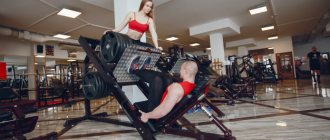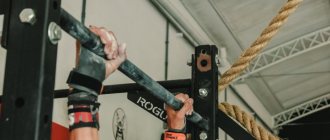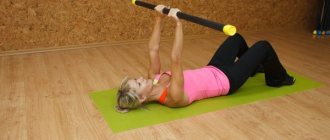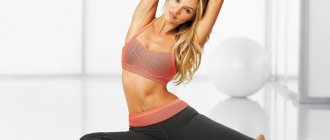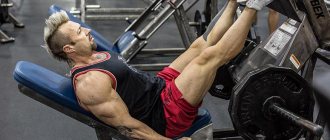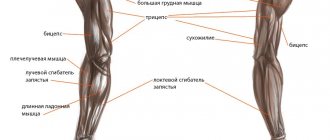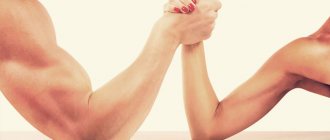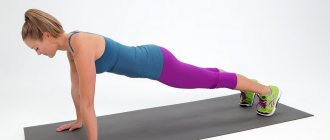Biceps are as simple as five cents
From a biomechanical point of view, when the arm is flexed, the biceps brachii muscle becomes fully tense. That is, there are no special movements to tension the inner or outer head of the biceps. And there are no special exercises to create a biceps peak like the legendary Arnold Schwarzenegger.
The shape of the hand is a genetically determined factor. The peak of the biceps is either present and clearly defined, or it is weakly expressed or absent altogether. You just have to come to terms with this. In any case, well-developed arms look great regardless of their genetically determined shape.
The most important thing is that developing them is not difficult if you do it wisely both from the point of view of physiology and the training process.
Dumbbell curls (different grips)
The exercise is additional, finishing. With this exercise you will be able to finally refine the muscle exhausted by lifting the barbell. This exercise can be performed standing or sitting. Different rotations of the brushes are also possible. Turning the hands helps redistribute the load on different muscle bundles of the biceps.
- To start performing the exercise, you need to determine the position of the body when performing it: sitting or standing. To perform standing, you only need dumbbells. To perform while sitting, use dumbbells and a bench.
- The mechanics of performing the exercise is to bend/extend the arms in a vertical plane. The arms at the starting point are located along the body, palms facing each other. At the top (end) point they are close to the chin. You can perform arm curls at the same time, or alternately. Depending on which beam the load is directed to, at the top point of the arm you do/don’t rotate the hand.
The exercise consists of 1 warm-up approach and 3 working sets. The warm-up approach is done with 60-70% of the working weight. Number of repetitions in warm-up and working approaches: 10-12.
For a visual representation of how to perform the exercise correctly, watch the video below:
Exercises for the chest. Dumbbell bench press.
What factors cause muscle growth?
Before moving on to the exercises, let's look at the main factors of muscle growth. This is necessary for a clear understanding of the appropriateness of the exercises that we will consider below.
To simplify it as much as possible, muscle development requires building material (amino acids), energy (glucose), hormones (the body synthesizes them in response to training stress) and muscle tension or tension, which initiates growth. Moreover, sufficient muscle tension is the main factor , without which there will be no progress, even if the accompanying conditions are met.
Accordingly, for effective development of muscles, including biceps, it is necessary to create conditions in which there is noticeable muscle tension without unnecessary stress on the ligaments and tendons. This is achieved by using the correct technique for performing the exercise and understanding its biomechanics.
In the case of the biceps brachii muscle, for example, the grip width of the barbell during a classic biceps curl does not matter. Let me remind you that with any bending of the arm, both heads of the biceps are always tense. Thus, the grip should be comfortable to maximize muscle tension with minimal stress on the hands and elbows.
This is much more effective than trying to pump up the outer and inner heads of the biceps separately by varying the grip width. You will spend more time, and due to a grip that is too wide or too narrow, you will overstrain your joints and ligaments, which will not allow you to create sufficient muscle tension. Progress in increasing the weight, and therefore adapting the muscle to the load through its growth, will stop before the size of the biceps begins to please you.
Exercise "Hammer"
A modified technique for training the brachioradialis muscles and wrist extensors. Recommended for use at the end of the program.
- IP - arms with dumbbells are lowered down, hands are turned towards the body, triceps are pressed to the body.
- With the forearm stationary, bend the left arm until the bundles are completely contracted. The projectile should be on the shoulder line.
- Strongly straining the biceps, we pause for a short pause.
- We return the hand to IP.
- An action with both hands counts as 1 repetition. You need to make 8x3 of these takes.
The exercise is not considered basic, so it makes no sense to take a lot of weight. The “hammer” can be done while standing, on a bench with support, bending your arms alternately, at the same time. It is easier for beginners to master the alternating technique.
The most effective exercises for developing biceps
There are only five of them, and in reality three will be enough. Additional exercises are only needed to diversify the training process.
In fact, to effectively develop the biceps brachii muscle, having a barbell and a pair of dumbbells is enough. But you can, in principle, get by with just one barbell and train large biceps with one exercise. Let's start with him.
Best exercise
You will be surprised, but the best exercise for biceps is squats with a barbell on your shoulders! And it's not a joke. Bodybuilding techniques have long confirmed this fact.
With a well-designed program, the first 2-3 years are devoted to gaining total muscle mass and increasing strength. This means an emphasis on training the legs (50% of the total mass) and back (30%).
Muscle growth in small muscles such as biceps, triceps, shoulders or forearms depends on the growth of overall muscle mass. At least for the first few years of going to the gym.
Bodybuilding practice has shown that in order to increase the volume of your arms by 2 cm, you need to gain 5 kg of total muscle mass.
And you can gain such mass quickly only by training your legs and back. Well, the most effective exercise for growing leg muscles is squats with a barbell.
So it turns out that if you want big biceps, accept the fact that you need to pump up your legs and back.
50 cm of arm volume corresponds to a body weight of at least 100-110 kg. And for tall men, taller than 180 cm, the weight can reach 115-120 kg.
Move on to specialized programs for pumping up your biceps only when the muscle and strength foundation has been laid.
This is where the time comes when we train the biceps, as professional bodybuilders do - exclusively with isolation exercises. Only at this stage will such techniques give a pronounced positive result.
Barbell Curls (Biceps Curls)
The favorite exercise of all young guys who have just reached the gym, along with the bench press. And both of these exercises are usually done incorrectly, which negates any progress.
The main mistake is that the elbows are brought forward , and this cannot be done. The elbows should remain in place, as shown in the video above. In this case, the load falls only on the biceps brachii muscles, and there is no moment of their relaxation in the peak position.
If your elbows are under the barbell, the load will go into them (the force vector is directed downward), and the biceps will relax. Naturally, there is no talk of peak reduction. It is impossible to do it in this position.
As for the grip, grab the bar approximately shoulder-width apart so that your hands do not bend in the horizontal plane. In addition, do not bend your hands towards yourself at the top position of the barbell. They always remain in the same position.
Having raised the barbell to the top position, hold for 0.5 seconds, “squeezing” the muscle into peak contraction. When lowering the projectile down, do not relax your arms and do not fully extend them.
I also recommend using a curved bar, which will allow the hands to be in a natural position, turned inward at about 45°. This practice will prevent them from overexerting themselves as the weight increases.
Top 9 biceps exercises at home
In this article, we will discuss the exercises that are most suitable for developing biceps fitness at home with dumbbells and a horizontal bar.
Standing Dumbbell Raise
- Stand up straight, pick up objects of the same weight.
- Bend your elbow, lifting the weight to your shoulders.
- Hold the dumbbells horizontally, with your fingers facing you.
Keep your back straight to avoid damaging your spine.
Use only your biceps for the lift. If you sway, your back muscles will come into play and the effectiveness of the exercise will decrease. The biceps should contract and extend completely. Read more about dumbbell curls →
Hammer lift
- Stand straight, hold dumbbells with the same weight in both hands.
- Hold them vertically, fingers facing each other.
- Bend your elbows until the contraction is complete at the top.
Don't use other types of muscles that are activated by swinging your body. You should lift the weight exactly with the biceps only, and not with a wave, in which case you can quickly pump it up at home.
Read more about the hammer exercise →
Lifting dumbbells with emphasis on a bench
- Place your hand on the conditional simulator so that it is fixed under your armpit, elbow down.
- Bend your arm at the elbow, without lowering your arm all the way down or raising it all the way up.
Any vertical object at an angle that you can find at home will be suitable as a simulator for pumping up your biceps. The hand should not hang, but should not lie on the machine. The advantage of this exercise is that it will work exclusively the biceps without activating the core. Full extension and contraction are unnecessary movements that simply load the joints and exhaust the arms, but do not contribute to the quality development of the biceps. Therefore, do not do it at full amplitude .
Read about how to do exercises on the Scott bench here →
Seated dumbbell raise
- Sit on a chair with your back turned (to make it easier to keep your back straight).
- Take the same weight in your hands.
- Work at full range.
Almost the same as the standing exercise, but the set is progressive. Sitting puts more stress on the biceps, as the whole body works less. Sit up straight and don't sway to the sides.
Concentrated dumbbell raises
- Sit on any height with your legs apart.
- Bend over and place your elbow on the inside of your leg near your knee.
- Lean on and begin to contract the biceps muscles, not to their full amplitude.
An excellent exercise that minimizes back and torso work. Thanks to this, the biceps develops faster and better.
Read more about the concentrated biceps curl →
Reverse grip pull-ups
- Grasp the bar with an underhand grip, fingers facing you.
- Hands should be shoulder-width apart.
- Pull yourself up to your chin, but don't go all the way down.
You don’t have to do it at full amplitude, since the lifting is done with the help of your back. To specifically pump up your biceps, this is not necessary. This is the best exercise on the horizontal bar and one of the most effective exercises for pumping up the biceps.
Narrow pull-ups with reverse grip
- Grasp the horizontal bar with a reverse grip, with your fingers facing you.
- Hands should touch each other.
- Pull-ups are done until the muscles contract completely, but without falling to the lowest point.
A narrow grip will also help develop your biceps, but will additionally strengthen your shoulders and shoulder blades. The exercises are alternating, so as not to load the same area, but just as effective for pumping the biceps muscle.
Standard elbow pull-ups
- Grab the bar with an overhand grip, with your fingers facing away from you.
- Hands should be shoulder-width apart and elbows facing forward.
- Pull up to full range.
If you push your elbows out to the sides, the entire load will go to your back and the biceps will do much less work. With the correct technique, in addition to the biceps, you can also pump up the forearm and triceps.
Read more about bicep pull-ups →
Pull at the doorway
- Stand next to the doorway.
- Grasp the doorway with one hand and place your feet next to it.
- Shift your center of gravity to the side so that you can avoid falling only because of the support of your hand.
- Pull yourself up to the wall with one hand.
You must pull yourself with your hand, not your feet. Keep your balance with your hands too. In this case, the biceps contracts and develops. Repeat the same on the other hand.
Lifting dumbbells for biceps while sitting on an inclined bench
An exercise as effective as PSHNB and complements it well on arm day.
The tilt angle of the bench is 45°. The main condition for performing the exercise correctly is keeping the elbow in place when lifting the dumbbell for the biceps .
The biomechanics of the movement are exactly the same as in the biceps curl. When the elbow remains in place, the entire load falls on the biceps brachii muscle and peak contraction can be achieved.
By bringing the elbow forward and actually placing it under the dumbbell, all the load goes from the biceps to the joint. The biceps muscle relaxes, peak contraction is impossible, and muscle tension is completely lost.
To place your elbows in the correct position, just sit on a bench and simply lower your arms with the dumbbells down. This is the starting position and the elbows should remain in this position throughout the entire exercise.
The technique of execution is for the most part similar to that in PSHNB: peak contraction at the top, do not relax your arms at the bottom. You can raise both hands together, or alternately. In the latter case, keep the “resting” arm slightly bent, maintaining slight tension in it.
The difference from PSHNB is only in the supination of the hands. That is, in the lower position the dumbbell is parallel to the body, in the upper position the hand turns outward.
Isolation exercises
Basic exercises are good, but you shouldn’t forget about isolating exercises. With their help you can pump up individual biceps bundles.
Lifting the barbell while standing with a reverse grip
This exercise has many benefits:
- The coveted high peak appears at the biceps;
- The volume of the forearms visually increases;
- Elbows have additional protection from injury;
- The wrists are strengthened;
- Relief appears on the hands.
Technique:
- Lower your shoulders down and press your arms to your body;
- Bending should only occur at the elbows;
- The arms should extend only upon reaching the lowest point;
- Exhale forcefully and calmly bend the barbell.
Lifting the barbell on a Scott bench
This exercise was invented by Larry Scott. It is he who should be thanked for creating such a bench. This type of lifting of the barbell perfectly works the biceps.
Technique:
- Sit comfortably at a bench and place your hands on the surface;
- Take the barbell. It will be better if your training partner serves it to you.
- Start bending your arms, calmly lifting the projectile to your chin;
- Gently lower your arms with the barbell to the original position.
Useful tips:
- You don’t need to lower the bar too low - this way you’ll work your arms better;
- If you feel pain, change your grip;
- Always maintain tension in the tendons throughout the entire approach.
Concentrated dumbbell raises with supination
It is often found in the programs of both beginners and professional athletes.
Let's look at the correct technique for concentrated biceps curls. In this case, we will sit and lean on the thigh:
- Sit on a bench and spread your legs wide;
- Take a dumbbell in your hand and lower your body a little;
- Rest your elbow on your thigh, it is recommended to place your other hand on your other leg;
- Raise the dumbbell to your shoulder, stay in this position for a couple of moments and return to the original position.
Hammer Grip Dumbbell Curls
This exercise is mainly aimed at developing the small muscle between the biceps and triceps - the brachialis .
It gives the arm a more impressive, athletic shape, so to speak, increases its thickness and has a good effect on the development of overall strength of the shoulder and forearm.
We perform the exercise standing, shoulder blades retracted, elbows held in a natural position at body level, do not move forward, perform a peak contraction at the top, do not relax the arms at the bottom.
You can raise both arms at once or alternately, without fully extending them at the bottom. In the latter case, we maintain a slight tension in the “resting” hand.
Exercises on simulators
A training complex for pumping up biceps will be complete if it includes muscle development using exercise machines. This will greatly increase your training productivity.
Arm curls on a machine using a lower block
- stand in front of the exercise machine;
- take the handle of the lower block with a reverse grip;
- bending your elbows, pull the handle towards your shoulders;
- return to their original position.
To ensure that the entire load is placed only on the biceps muscle, the elbows are pressed to the body. An alternative option would be to use ropes. Bent fingers, if the exercise is performed on ropes, should be directed towards each other.
Crossover bends
Standing straight, feet shoulder-width apart. Hands grasp the handles of the projectile and pull them to the top of the head. When the arms are extended, they should remain tense and the load should not drop completely. When inhaling, the arms are extended, and when exhaling, they are bent. The recommended number of repetitions is 8-12 times. Approaches are done from 1 to 2.
Most often, crossover curls are performed as a final exercise.
Standing dumbbell curl
An alternative to doing dumbbell curls while sitting on an incline bench.
The technique of performing the exercise is similar to that of lifting dumbbells for biceps with a “Hammer” grip, but there is supination of the hand in the upper position.
The shoulder blades are brought together, we keep the elbows at body level, we don’t move them forward, we do a peak contraction at the top, and we don’t relax the arms at the bottom.
You can raise both arms at once or alternately, without fully extending them at the bottom. In the latter case, we maintain a slight tension in the “resting” hand.
BICEPS CURL WITH RUBBER
EXERCISE TECHNIQUE – step on the rubber with both feet, feet shoulder-width apart, back straight, abdominal muscles tense, then holding both ends of the rubber in your hands, perform arm curls up to your chin, straightening your arms, do not let your biceps rest, keep it in constant tension. This is usually used at the end of a pumping exercise.
TIPS – To make your arms as engorged as possible and visually enlarge them for a short period of time, perform the maximum amount of flexion at speed for 30 seconds.
Working in a biceps machine
Another alternative to the classic biceps curl. Often people prefer this particular exercise, considering it more effective, since they “feel the muscle” in it better.
In fact, we are talking only about rigid fixation of the elbows and a clearly defined amplitude, which does not provide freedom in movement for performing the exercise incorrectly. If you perform PSNB with the technique described above, you will feel the muscle just as well.
However, there are a few important rules when working with a biceps machine. So, the shoulder should lie completely on the pillow, avoid just resting on the elbows. To do this, select the desired seat height.
In addition, do not fully extend your arms, maintaining tension in them. In the top position, do not bend your hands towards yourself; they remain straight all the time.
Training program
Below are several programs with exercises in the gym for men for biceps, developing mass. Each biceps workout program for the gym is designed for different fitness levels.
Proper warm-up
The gym is equipped not only with exercise machines and free equipment, but also with cardio equipment that you can use to warm up before your biceps workout. Each workout should begin with a 7-10 minute warm-up; this will sufficiently warm up the muscles, preventing fiber injuries. A high-quality and sufficient warm-up, with a little sweating, will warm up not only the biceps, but also other muscles and joints. On each cardio machine, it is also important to take the correct body position, this will ensure the correct load when warming up.
For newbies
What matters is how much weight you use to pump your biceps with dumbbells. Pumping up the biceps should be done with moderate weight; this is important for a beginner whose muscles have not become toned, and heavy weight can only injure the muscles and not build them. We pump up the biceps with moderate weights for a month, after which we change the program and add working weights. For beginners, we recommend training your back and biceps in one day.
- Pull-down of the upper block behind the head 3x10-12.
- Upper block row in front of you with a wide grip 3x10-12.
- Lower block pull to the belt 3x10-12.
- Hyperextension 3x10-12.
- Standing barbell lift 3x10-12.
- Curling arms with dumbbells 3x10-12.
For advanced
One set of biceps exercises at the gym will also include back and biceps on one day, and another will include biceps and triceps. For advanced athletes, when working on the biceps, multi-repetitions are not needed to increase mass, unless it is work on relief or a drop set is not provided. Also, chest and biceps exercises are not needed at the same time; you need training in the gym for synergistic muscles that interact with each other. Biceps exercises should be accompanied by a killer load, with maximum weight.
Option No. 1 (back, biceps):
- Wide grip pull-ups 4x8-12.
- Upper block rows in front of you with a reverse grip 4x8-12.
- T-bar row 4x8-12.
- Bent-over dumbbell row 4x8-12.
- Seated barbell lift 4x8-12.
- Lifting the barbell with a narrow grip on a Scott bench 4x8-12.
- Raising dumbbells on an incline bench 4x8-12.
Option No. 2 (biceps, triceps):
- French press 4x8-12.
- Standing extension with ropes 4x8-12.
- One-arm bent over extension 4x8-12.
- Bending arms in the lower block 4x8-12.
- Lifting the barbell with a reverse grip 4x8-12.
- Standing dumbbell raise 4x8-12.
How to train biceps
The biceps is a small muscle, but actively works in almost all deadlifts as a synergist. That is, it helps the back muscles, for example, in pulling a barbell to the stomach or pulling a block to the chest. Accordingly, it is easy to overtrain if this factor is not taken into account. In a permanently overtrained state, naturally, nothing will grow.
For the effective development of any muscle group, it is advisable to give it enough time to recover, and then load it with a certain frequency. On average, recovery time ranges from 48 to 72 hours.
In the case of biceps, an excellent option is when in one workout in a weekly microcycle they are loaded only as synergists, and in the second there is a separate arm workout with a couple of exercises directly on the biceps muscle.
There are actually a lot of schemes, both for a 3-day split and for a 4-day one. It is important to understand the principle itself, which I will describe using the example of a microcycle below.
DAY 1: Back + Triceps DAY 2: REST DAY 3: Legs + Shoulders DAY 4: REST DAY 5: Chest + Biceps DAY 6: REST DAY 7: REST
On the first training day, the biceps works as a synergist in back exercises (plus the rear delta), while the triceps are fully pumped.
On the second training day, we load our legs and shoulders to give our arms a good rest.
On the third training day, the triceps work as a synergist (plus the anterior deltoid) in chest press exercises, and the biceps are trained fully (PSNB + seated dumbbell lifts + Hammer). Thus, the arms are worked out twice a week and still have time to recover well.
As for the training protocol, vary the number of repetitions in biceps exercises from 8 to 15, and the number of approaches - up to three working sets. Don't forget about a good warm-up, gradually increasing the load and cycling. You can read about this in detail in the feature article.
Recommendations for an effective biceps workout
The key to success lies in properly organized training. This allows you to avoid both injury and excessive fatigue. If an athlete goes to the gym every day, exercises to pump up the biceps are performed every other time. A “day off” allows the muscles to recover.
You should start exercising only after warming up. Otherwise, there is a high probability of tendon rupture. If an athlete feels the need to focus exclusively on biceps, such training should be carried out no more than once a week.
Intense training cannot be done every day. The athlete must take a one-day break from training. You can devote it to visiting a sauna or Russian bathhouse.
Igor April 1, 2016
